Chinese Elm Bonsai Tree Care
Ultimate Species Guide
The Chinese Elm bonsai tree, also known as Ulmus parvifolia, is native to most of eastern Asia, including regions such as China, Japan, Taiwan, North and South Korea, and Vietnam. The first specimen in the UK was collected by James Main from China. Many enthusiasts love growing this species for its stunning foliage and style variety.
Let’s take a detailed look at how to care for the Chinese Elm bonsai tree.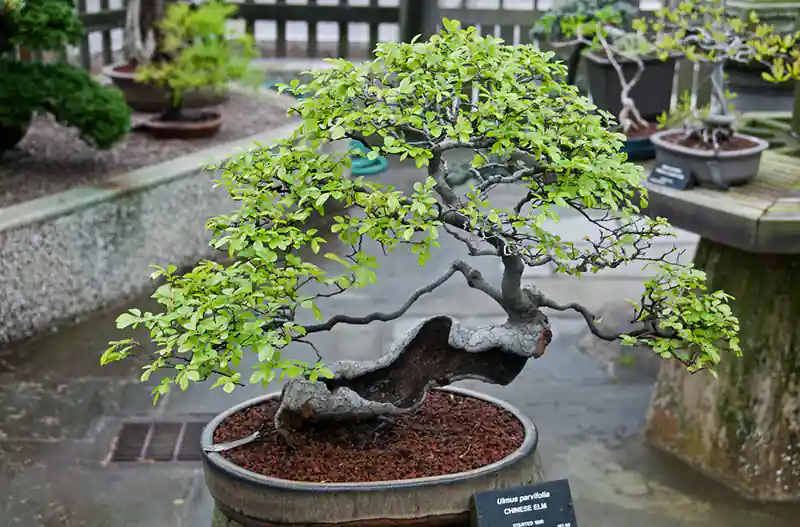 Image courtesy of 4.0 International
Image courtesy of 4.0 International
Quick Sheet For Chinese Elm Bonsai Tree Care
Before we head into the details of Chinese Elm bonsai care, here’s a quick TL;DR rundown of the aspects you need to consider.
Recommended soil
Standard mix, good drainage
Watering
Summer: daily, winter: when needed
Potting season
Late winter, early spring, every two years
Shaping and pruning season
Summer and spring: Maintenance
Late autumn: Design
Light
Full sun or partial shade
Humidity
Medium to high
Fertilizing
Spring: frequent light doses
Summer: heavier doses
Autumn: light doses
Winter: none
Propagation methods
Cuttings, seed, air layering
Pests and diseases
Early blight, black spot, spider mite, scales
Growth patterns
Branches and leaves grow rapidly in spring and summer, resulting in vigorous pinching and pruning
Recommended styles
All styles can be used, while shohin is stunning
Native area
Eastern Asia
Chinese Elm Scientific Name
- Class: Rosids
- Order: Rosales (rose)
- Family: Ulmaceae (elm)
- Genus: Ulmus (elm)
- Species: Ulmus parvifolia (Chinese elm)
How To Care For A Chinese Elm Bonsai
We’re heading into the exciting part of our Chinese Elm bonsai care and fact sheet. You’ll see details of every element you need to consider, especially where it comes to the survival of your miniature tree. While it can be exceptionally forgiving, you should look after it as much as possible for healthy leaves, roots, branches, and flowers.
Light And Placement of your Chinese Elm Bonsai
In this first section, we’re going to look at where you can place your Chinese Elm bonsai tree indoor or outdoor and how much sun it needs. It’s essential for health and growth, especially when understanding the effects on photosynthesis and food production.

Can You Keep Chinese Elm Inside?
Many bonsai stores promote Chinese Elm trees as indoor bonsais, as they do well with limited light and high humidity. As long as you let it gather enough sunlight in the morning hours, there’s no reason it shouldn’t do well inside your home. You should ensure that no pets or children can damage it where you’ve placed it.
Can You Keep Chinese Elm Outside?
While you can certainly grow them indoors, you’ll find the Chinese Elm bonsai thriving outside in the warmer months. They usually present an evergreen nature, but they may lose their leaves when the temperature is too cold. If you have severe frost in winter, it’s better to bring it inside.
Can Chinese Elm Take Full Sun?
Whether it’s summer or winter, your Chinese Elm bonsai tree will love direct sunlight for the first four hours of the morning. The ideal location inside or outside is where it can receive partial shade for the afternoon towards the evening. The harsh sun can burn the delicate leaves, which cause issues with photosynthesis and may lead to the development of diseases.
Watering your Chinese Elm Bonsai
One element that’s critical for all bonsais is water. The Chinese Elm tree can become thirsty in the warmer months, but you’ll need to know how regularly to water it throughout the year.
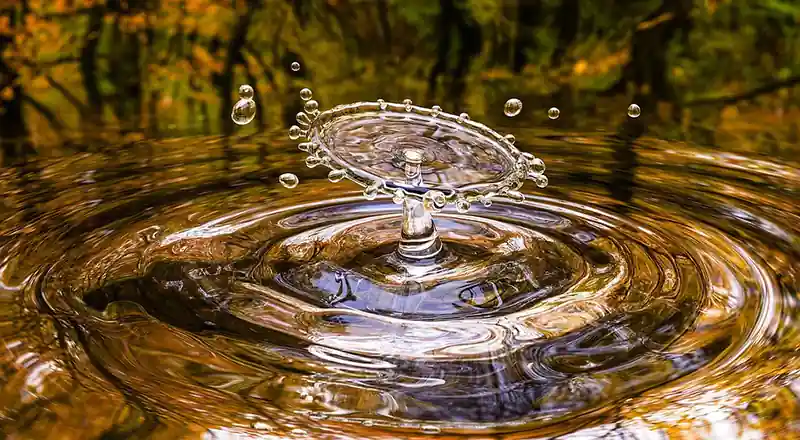
How Often Should You Water A Chinese Elm Bonsai?
How much you water your Chinese Elm bonsai will depend on the season. In spring and summer, you can expect daily watering in the early morning. When autumn arrives, you can switch to every second day, while winter relies on once a week.
How Much Water Does A Chinese Elm Tree Need?
You’ll need to check on your Chinese Elm bonsai tree daily to see its watering needs. Press your finger into the soil to see how dry the top layer of soil is. If there’s little moisture, feel free to let it water, as long as there’s sufficient drainage. In winter, the requirements will be lower.
Can You Overwater A Chinese Elm?
Overwatering your Chinese Elm tree can cause serious damage to your bonsai. While it may be thirsty, you can still provide too much water that may lead to root decay. If you see the leaves are turning yellow, the soil smells strange, or the roots are dying, you’re giving it too much water. There are ways you can fix an overwatered Chinese Elm, though.
Chinese Elm Tree Feeding, Potting, And Soil
The next component you’ll want to focus on deals with feeding, stability, and sufficient drainage. You’ll also want a decent pot to compliment your Chinese Elm bonsai. Here are the aspects you should take into consideration.

How Often Should You Fertilize Chinese Elm Bonsai?
Once again, Chinese Elm bonsai fertilizer needs depend on the season. In spring, you can feed it every two weeks in light doses, while summer requires heavier doses. In autumn, you can bring it down to once a month so the bonsai can store food for the winter, which is when you stop feeding it altogether.
When Should I Fertilize My Chinese Elm Tree?
The prime time to fertilize your Chinese Elm bonsai is either early morning or late evening, with the former being preferable. When the sun rises, your tree will soak in the rays to start food production and transport to cells. It will need that fertilizer ahead of time and not during the hottest part of the day.
What’s The Best Fertilizer For Chinese Elm Bonsai?
When spring arrives, you’ll want a fertilizer with a balanced NPK (nitrogen, phosphorus, potassium) ratio, such as 6:6:6. During summer, you can switch to a higher nitrogen ratio, like 10:6:6. Finally, reduce the nitrogen as soon as autumn hits, aiming for about 3:6:6. If you have other ratios, that’s not an issue, as long as you adjust the nitrogen levels accordingly.
How Do You Fertilize A Chinese Elm Tree?
How you fertilize your Chinese Elm bonsai tree depends on your preferred approach. If you’re going to use the liquid version with the indicated ratios, you’ll need to apply it as mentioned above during the respective seasons. Should you opt for solid pellets, they can last for several seasons, which means you don’t have to worry about them too much. Just make sure the NPK ratios are correct.
What Soil Is Best For Chinese Elm Bonsai?
When placing soil in your pot for a Chinese Elm bonsai, you’ll want to ensure that there’s about 75% inorganic matter. It usually consists of hard material or aggregate rock so that there’s sufficient drainage. You can also place a standard mix in the container, but make sure there’s a high saturation level so the water doesn’t clog the roots.
When Does A Chinese Elm Bonsai Need Repotting?
If you have a young Chinese Elm tree, you should repot it every two years. More mature bonsais can wait longer, as the roots take longer to extend into the soil and are mode developed. The best time is in late winter just before the new leaves break out in spring.
Structure And Foliage of the Chinese Elm Bonsai
The structure of a Chinese Elm bonsai is one of the most beautiful you’ll ever see. Even if the leaves don’t fall in winter, you can admire the leaves and branches any time of the year. Let’s take a look at what you can look forward to.

Image courtesy of 4.0 International
Do Chinese Elm Bonsai Lose Their Leaves?
While Chinese Elm trees are evergreen in nature, they do have semi-deciduous properties if the temperature drops too much. Don’t worry; it’s normal. Also, it tends to drop its leaves every few seasons in winter when it wants to grow new ones in spring. You should only worry if the leaves look unhealthy in spring or summer.
What Do Chinese Elm Leaves Look Like?
Chinese Elm leaves have dark green leaves when they mature, which may appear slightly red when they first appear. The upper side of the leaves is glossy, while the edges are serrated. The tree has alternatively arranged leaves around the branches. They’re usually up to 2 inches long, depending on how regularly you prune.
Can You Eat Chinese Elm Leaves?
While many people usually eat Chinese Elm seeds, you can also do so with the leaves, whether raw or cooked. It’s slightly bitter, but there are a few meals you can make while adding the leaves to the pot. Some say that the taste is similar to New Zealand spinach.
Do Chinese Elms Shed Their Bark?
One exciting aspect of the Chinese Elm is that the bark sometimes peels off every few years. The Drake variety is especially known for shedding its bark, giving a fantastic appearance in late spring or early summer. So don’t stress when you see your bonsai dropping its bark; take some photos and share them with us on our Instagram account.
What Does The Bark Of A Chinese Elm Look Like?
The bark of your Chinese Elm bonsai will depend on the variety. In general, it has multiple hues of brown and other colors in mottled splashes. You may even find orange and green on it, which is normal and not a disease. Due to this appearance, it’s sometimes called the Lacebark Elm.
Does A Chinese Elm Tree Bloom?
The Chinese Elm bloom will show a showering of small flowers in late summer in the right conditions. When pollinated, you’ll see small green fruit that contains the seeds for future bonsais. You’ll see plenty of flowers if you practice the correct pruning and ramification techniques in spring.
Chinese Elm Bonsai Maintenance And Cultivation
To have a wonderful structure for your bonsai, you need to maintain and cultivate it. It involves pruning, shaping, and styling. In this section, we’ll show you how to apply it to your Chinese Elm tree.
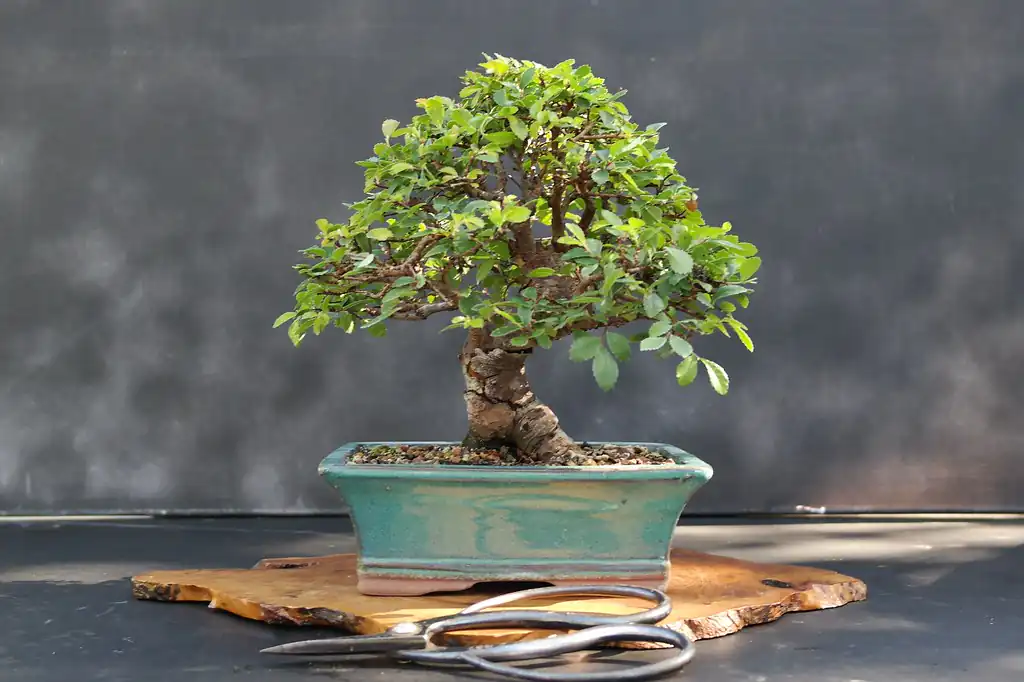 Image courtesy of 4.0 International
Image courtesy of 4.0 International
How Do You Prune A Chinese Elm Bonsai?
The best way to prune the Chinese Elm bonsai is using the clip and grow technique. Let it extend quite a bit from the base, and then cut back to four leaves. In this way, you keep the leaves small while letting more branches grow into dense foliage.
When Should You Prune Chinese Elm?
Spring and summer will show you tremendous growth in the leaves. It’s best to do some hard Chinese Elm bonsai pruning only when you see the branches extending too far from the shape you want. When autumn arrives, you can do some design pruning before winter to keep the structure intact.
How Often Should You Trim A Chinese Elm Bonsai?
Due to how vigorous the growth is, you may need to trim back about three times a year. Between the hard pruning in spring and design pruning in autumn, you can trim the stems back about once a month, depending on when you see the growth spurts. It helps to develop new leaves and branches for the structure.
How Do You Shape Chinese Elm Bonsai?
The shape you decide on will depend on the style you’ve chosen. When you have a design in mind, make sure you let the branches grow beyond that and then cut back. In this way, you make provision for the new stems to form while allowing for denser foliage. Don’t let branches cross over each other so there’s still enough room to breathe and absorb sunlight. Wiring a Chinese Elm bonsai can also help you with the shape.
How Do You Style A Chinese Elm?
There are plenty of forms you can use with Chinese Elm bonsai styles. Some of the more popular ones are formal, informal, twin trunk, and exposed root. The tree is also an exceptional choice for shohin, which means growing it in the smallest possible size.
Winter Care of the Chinese Elm Tree
Taking care of a Chinese Elm bonsai in winter is easy because of how hardy the tree is. However, there are some aspects you need to consider to make sure it survives in your region. Don’t neglect it; otherwise, it may die.

How Hardy Is Chinese Elm?
The hardiness zone for the Chinese Elm is between regions 5 and 9. That means it can withstand some cold temperatures to a certain degree. For this reason, you should bring it inside when it becomes too cold or there’s frost in your area.
When Should I Bring My Chinese Elm Inside?
The best time to bring your bonsai inside is when the temperature drops below 60°F. You’ll notice that it loses its leaves, even when brought indoors, and you may notice the bark changing or frost collecting on the branches. It may become susceptible to pests and diseases if not cared for correctly.
How Do You Overwinter A Chinese Elm Bonsai Tree?
Overwintering your Chinese Elm bonsai will help protect it from frost and diseases. In warmer climates, it will retain its green leaves without developing more. To do so, bring it indoors where there’s still some indirect light, or place it in a tented greenhouse that keeps it warm with sufficient light.
Which Temperature Range Does The Chinese Elm Prefer?
The Chinese Elm doesn’t like too much variation in temperatures. The ideal range is between 60°F and 70°F. There’s a good chance it can survive outside these limits, but it’s not fond of it. You may see changes in the leaves or roots, but you’ll need to keep a close eye on them.
Do Chinese Elm Bonsai Need Dormancy?
Since the Chinese Elm has evergreen properties, it’s not completely necessary for it to go through dormancy. However, it is semi-deciduous, so we recommend that you do let it rest in winter so that it doesn’t become exhausted. Don’t feed it or let it have too much sunlight in winter so you can see rich foliage in spring.
Chinese Elm Bonsai Propagation
The one beautiful aspect of bonsais is that you can grow them freely from seed or cuttings, giving rise to new life. Fortunately, the process is easy for the Chinese Elm tree if you know how.
Here are a few pointers, but feel free to read our full Chinese Elm propagation guides.
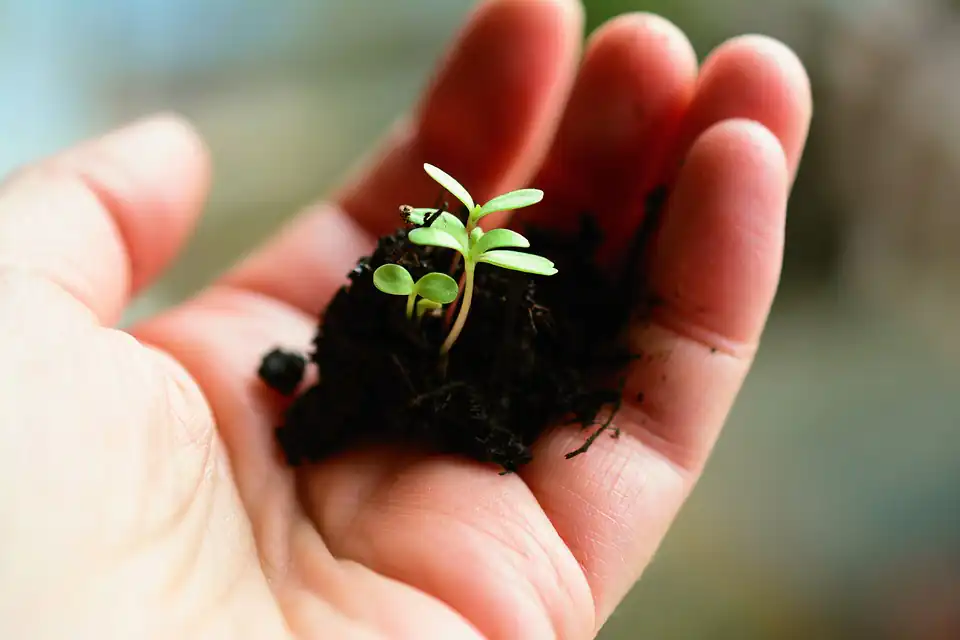
Do Elm Trees Produce Seeds Every Year?
If you have a mature Chinese Elm tree, you’ll see flowers and seeds every year. It will start with only a few seeds in the first year, with more added as each year progresses. When it hits 40 years, you’ll see that it hits its peak in seed development.
However, you’ll have to wait a long time before you see the first seeds. Many Chinese Elm bonsais only show seeds when they reach 15 years of age. The patience pays off when you have the first batch and attempt to grow new trees.
How Long Does Chinese Elm Take To Germinate?
When you finally have a Chinese Elm bonsai that develops seeds, you’ll wait about two to three months from pollination to germination. The process for propagating seeds takes quite a while, as you need to let them grow roots in a specific way. If you try to take shortcuts, the seeds may not develop properly and die shortly after germination.
The recommended process is taking the winged Chinese Elm seeds and soaking them for a day. After that, you place them in the fridge for a few weeks until they start showing signs of germination. When they’re ready, you can place them in the soil that you’ve prepared for the seedlings.
Can I Grow An Elm From A Cutting?
The easiest way to perform Chinese Elm propagation is via cuttings. It’s best to take the cutting when your bonsai is growing well in spring or early summer. Prepare the soil, making sure you use rooting hormone to help the roots develop in moist soil.
You should use a branch that is semi-hard and not completely green. Use a length of about 6 inches, and remove the lower leaves. When you see new buds forming and the stem is hard to tug from the soil, you know the roots have formed.
How Long Does It Take For Chinese Elm Cuttings To Root?
If you place the Chinese Elm cutting in a pot that’s sealed in a bag, the process can take up to ten weeks or more. It all depends on the conditions you’re growing it in. You’ll need to make sure there’s sufficient water for the roots to develop in.
When the roots do form, make sure the soil you provided has enough nutrients. Don’t fertilize for the first season, as the bonsai soil you buy should already have the required minerals. By the second year, you should see new leaves forming. That’s when you start feeding it.
Can You Air Layer a Chinese Elm?
It’s completely possible to air layer a Chinese Elm, as the tree is hardy enough to survive the process. You’ll need to ensure that the layer of bark you remove and the section exposed is entirely protected from diseases and pests. As soon as the new stem develops roots, you can safely remove it and plant it as a new bonsai.
Chinese Elm Pests And Diseases
In the final section of our care guide for the Chinese Elm bonsai, we’ll look at the pests and diseases to look out for. Younger trees are more susceptible to them, while more mature ones are hardier. Make sure you inspect them daily, even in winter, to ensure they remain protected.
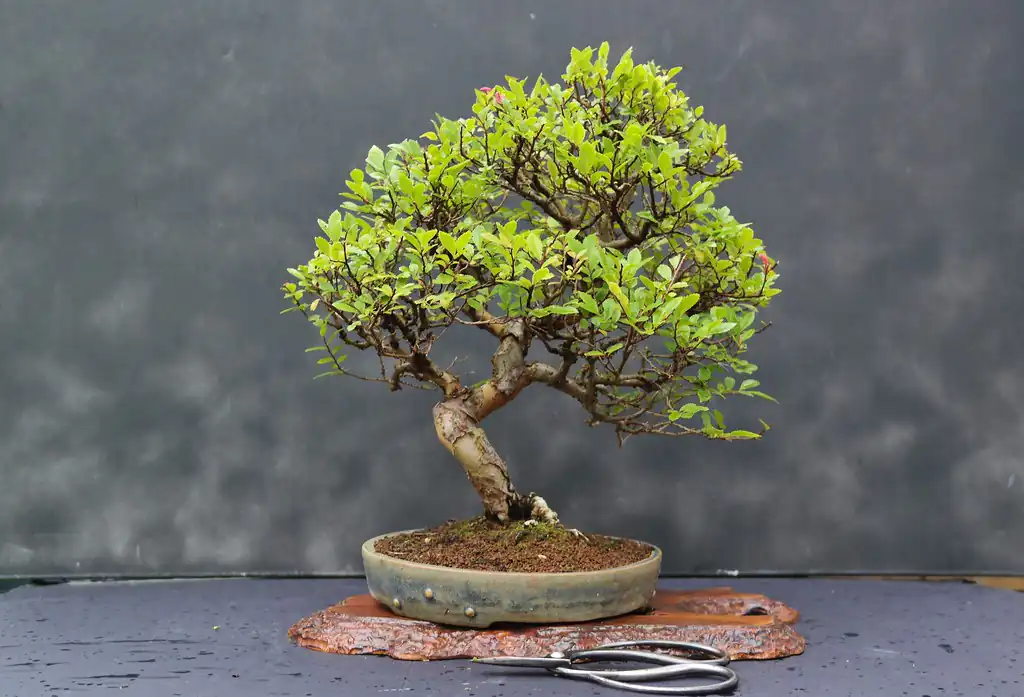 Image courtesy of 4.0 International
Image courtesy of 4.0 International
How Do You Save A Dying Chinese Elm Bonsai?
If you see your Chinese Elm bonsai is dying, there are some steps you can take to revive it. It may not be too late to save it, as long as the roots are still good.
- Remove any dead sections
- Evaluate the cambium to see if it’s still green
- Prune the roots and repot in new soil
- Place the soil in water for about 30 mins
- Put your bonsai in a location with indirect sunlight
- Continue to regularly water your bonsai
- Wait for your bonsai to show signs of new life
Common Problems With The Chinese Elm Bonsai
Those who own this magnificent tree have most probably encountered one of several problems that come with it. Here are a few issues worth noting for the Chinese Elm bonsai:
- Yellow leaves: There are many reasons this can happen. For one, you may be overwatering, or there’s not enough humidity inside. Another one is that there’s not enough natural light at the location. Make sure you get placement right.
- Small flies: These pests usually make a home in the foliage to hide from other predators. When they realize it’s safe, they produce babies that cause an infestation. You can use regular insecticides to get rid of them.
- Weak, long growth: This issue is resolved with the correct placement again. If it’s too dark in your house, it will shoot long branches to find the light. However, they remain weak. You’ll want to move it to a sunnier spot.
Why Is My Chinese Elm Losing Its Leaves?
There could be several reasons for your Chinese Elm bonsai losing its leaves. Firstly, it does so when you’ve just bought one and moved it to your home. The tree needs to become used to the new air and climate, which is when it drops leaves and grows new ones.
The other reason is that you don’t have the right placement. While it does well with partial shade, it still needs a few hours of direct sunlight in the morning. You may also want to check if there’s sufficient drainage in the soil.
Why Are My Chinese Elm Bonsai Leaves Turning Brown?
Once again, this issue has to do with water. However, leaves turning brown on a Chinese Elm bonsai usually has to do with too little water. Check the soil with your finger and see if it’s dry. You may want to water a bit more during the week.
If there’s enough water, it could be that it’s receiving too much sun in the peak afternoon. The small serrated leaves are fragile and tend to burn when it’s too hot and the sun is directly above them. It generally happens more in tropical regions.
How Do I Know If My Elm Tree Is Diseased?
The leaves, roots, and branches of your Chinese Elm tree will quickly show you signs of disease. For the stems, you can peel a portion of the bark and look for purple lines or streaks. The roots will decay and break easily, while the leaves will look moldy or have black spots.
If you suspect there’s a disease, you can cut a thick branch and look for signs of decay or rot. There will be dark rings with stains on the diameter of the cut you made. The branches may also snap too easily.
Do Chinese Elms Get Dutch Elm Disease?
The American Elm tree is a species that doesn’t survive the Dutch Elm disease too well. Once it spreads, there’s no saving it. However, the Chinese Elm has resistance against Dutch Elm disease, so there’s little chance of it infecting your bonsai. The one you need to watch out for is the Yellow Elm disease, which is the one that may kill your small tree.
How Do You Treat Elm Tree Disease?
Unfortunately, there isn’t any treatment that will help cure a disease when it affects your Chinese Elm bonsai. All you can do is prevent its spread. Remove any infected leaves and branches, and eliminate any mildew you see. You can also use a fungal spray to ensure that the disease doesn’t move to other parts of your tree.
What Bugs Eat Elm Trees?
There are a few bugs that may feast on your Chinese Elm bonsai, specifically the leaves. The most common types are:
- Elm leaf beetle
- Bark beetle
- Spider mites
- Carpenterworms
- Asian longhorn beetle
General Guide
Now that you’ve seen the general guidelines to caring for a Chinese Elm bonsai, we’d like to supplement that information with some more fun facts. Here are some other details you may want to know so you can enjoy the experience more.
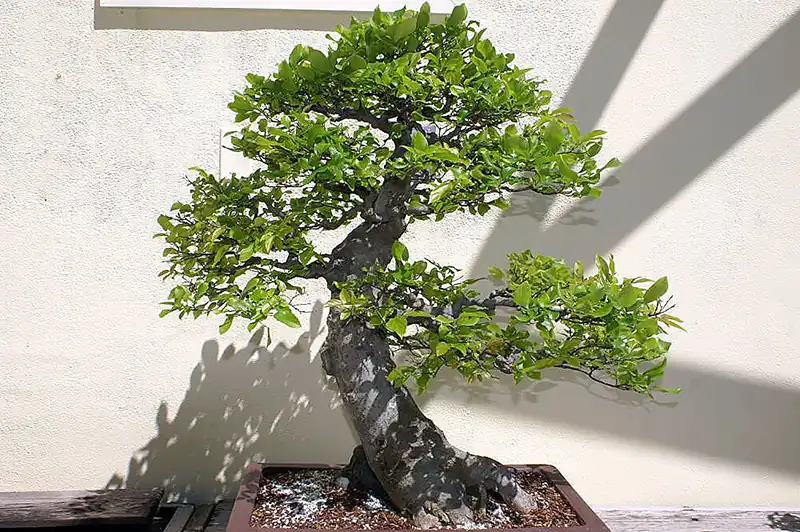
Image courtesy of 4.0 International
How Long Do Chinese Elm Trees Live?
In its natural environment, the Chinese Elm tree can live anywhere between 50 and 150 years. It first shows flowers that bear seeds at about 15 years, but many only considered it fully mature once it’s 40 years old. As a bonsai, it can also live as long as a mature tree, as long as you provide the proper care.
How Quickly Does A Chinese Elm Grow?
The Chinese Elm grows about three feet per year in the wild, which is why it sprouts so quickly as a bonsai. You’ll need to perform regular pruning throughout the warmer months to keep it in shape. In nature, you’ll see trees grow up to about 60 feet in height.
Is Elm A Hardwood Or Softwood?
When the Chinese Elm bonsai is young, you may see some softwood among the new stems. However, it’s considered a hardwood tree, as the Janka hardness rating is between 1200 and 1500 lbs. It is the hardest among the elm genus of trees and falls among the White Oak in comparison.
Is Chinese Elm Poisonous?
There’s no part of the Chinese Elm bonsai that’s poisonous, even to children and pets. As a matter of fact, you can eat the leaves and seeds raw or cooked. That’s why this tree is ideal as a bonsai for beginners in homes filled with family members and animals. Children will enjoy growing their own ones.
How Many Types Of Chinese Elms Are There?
In this section, we want to give you an idea of the different types of Chinese Elm trees you can grow as bonsais. Please bear in mind that they all form part of the same species; they’re simply different varieties.
Siberian Elm Vs Chinese Elm
First of all, we want to clear the confusion between the Siberian Elm vs Chinese Elm. Many people confuse the two, as they have many common properties. However, they’re different species in the same genus.
The main difference between the Siberian and Chinese Elms is that the former produces seeds in spring, while the latter does so in the fall. The lacey bark of the Chinese Elm is smoother than the Siberian Elm, which has a furrowed texture.
Chinese Elm Arizona
There’s a special selection of Chinese Elm trees that grow in the Arizona desert. Also known as evergreen elms, they present a stunning foliage display in the dry heat. However, they’re susceptible to root rot, even in the arid landscape.
True Green Chinese Elm
The True Green strain of Chinese Elm bonsais also does well in the hot, dry air. It has canopy foliage, which provides shade to the roots and soil. The bark is also hardy enough to withstand heavy wiring for when you want to shape your tree. The leaves are also a darker green than other varieties.
Variegated Chinese Elm
Also, known as Frosty Lacebark Elm, this version of the Chinese Elm tree has variegated colors on the leaves. You’ll notice a white lining along the edges or splotches among the green. The bark also has different colors, and it has excellent resistance to Dutch Elm disease.
Seiju Chinese Elm
As one of the more popular varieties to turn into a bonsai, the Seiju Chinese Elm is a dwarf version of the tree and is ideal for rock formations. The leaves become a stunning burgundy when the fall arrives, and you may even see red edges in late summer. The flaky bark also has various hues that range between gray, orange, and brown.
Cork Bark Chinese Elm
The Cork Bark Chinese Elm derives its name from the craggy bark along the trunk and branches. It’s one of the hardier varieties that the elm leaf beetle doesn’t affect. Since its leaves are smaller than the standard Chinese Elm, it’s ideal for cultivating any bonsai style where you want a rich canopy of foliage.
Chinese Elm Bonsai Inspiration
When you finally have a Chinese Elm bonsai, you may be looking for some ideas on how to shape and style it. There are plenty of places you can find inspiration if you know where to look. Here are some of our recommendations.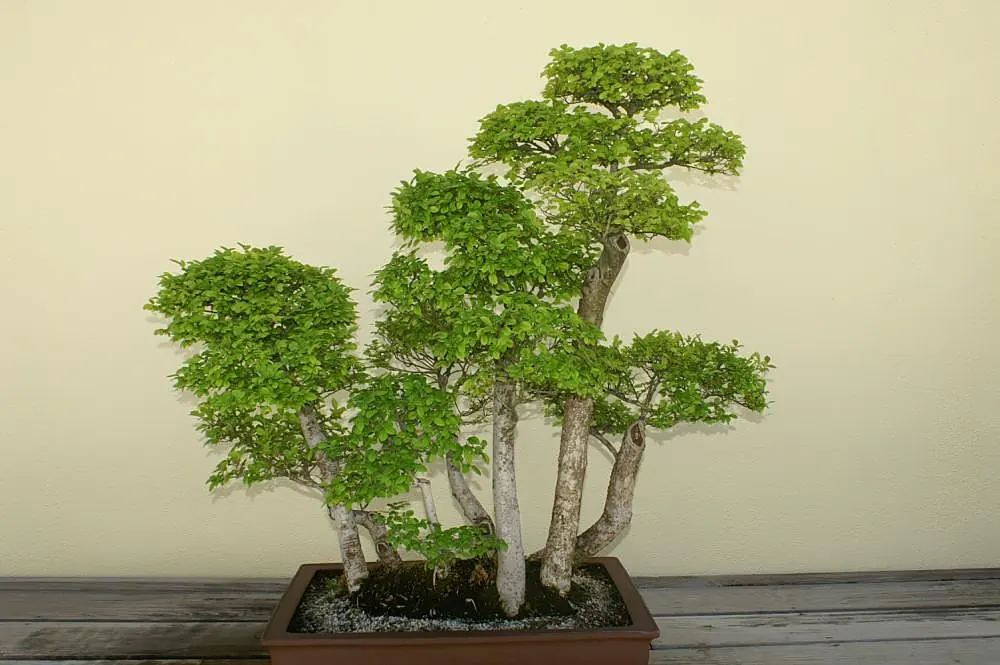 Image courtesy of 4.0 International
Image courtesy of 4.0 International
Photo Inspiration For The Chinese Elm Bonsai
One of the best places you can find inspiration for your Chinese Elm bonsai is via photos found on websites or social media platforms. We prefer using Instagram as our favorite hunting ground, and we’ll share a list of the top 10 channels or feeds for this almighty tree shortly.
Chinese Elm Tree Video Guides
Photos only go so far in assisting you with guides on how to perform specific tasks. In these situations, it’s better to turn to video tutorials, something Bonsai Alchemist is working on creating. For now, we’ll share a guide on the top 10 Chinese Elm bonsai videos to peruse.
Books On Chinese Elm Bonsais
Another avenue you can approach for Chinese Elm inspiration is a good book. You can choose between paperback or ebook, depending on what your preference is. There are several excellent titles you can find online or in your local bookstore. It can also be a generic bonsai book, as they usually have sections on this wonderful tree.
Chinese Elm Bonsais For Sale
Finally, take a look at Chinese Elm bonsais for sale online. We’re not saying buy one of them, but you can get a general idea of styles you can use from the sellers’ images on the product pages. Sometimes buyers also paste photos in the comments or reviews with the concepts they used.
Final Thoughts
As you can see, there are plenty of details when caring for your Chinese Elm bonsai. Sure, we could have shown you how in a shorter article, but then you’d miss out on some of the finer details. If you have any other questions, please feel free to comment or contact us.







